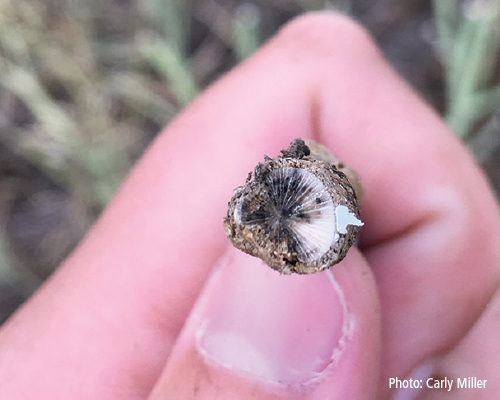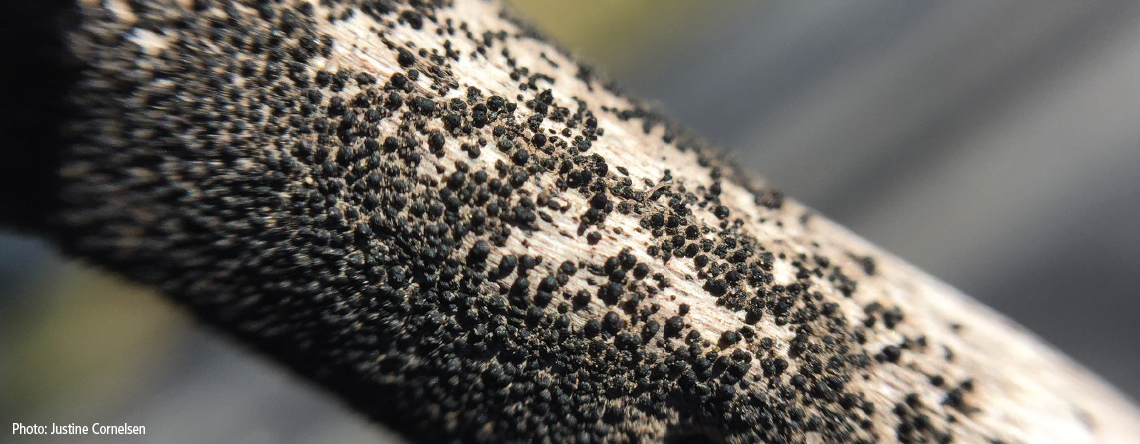Agronomists can help customers make crucial decisions to preserve blackleg resistance.
Blackleg is a stubble-borne canola disease with potential to cause serious yield loss. It can persist in fields for years if rotations are tight and, according to Justine Cornelsen, agronomy specialist with the Canola Council of Canada, some degree of blackleg infection can be found in approximately 70 to 75 per cent of fields across Western Canada.
Cornelsen shared this stat in her presentation at the Syngenta Canada Blackleg Symposium this fall in Winnipeg, Man. The symposium brought together industry and academic experts in canola disease management from Canada and Australia. Speaker presentations focused largely on the importance of preserving genetic resistance which Cornelsen calls our “most valuable tool” for combatting blackleg.
All canola sold and grown in Canada is rated R (resistant) to blackleg, but resistance has broken down in some areas due to the use of the same resistance genetics in tight canola rotations. As blackleg has evolved by overcoming sources of genetic resistance and adapting to its environment, growers now have to contend with different “races” of the disease pathogen.
“All varieties coming to market in Canada are resistant to blackleg,” says Cornelsen. “But, in some areas, depending on that particular area and depending on the variety, varieties that are resistant are performing like a susceptible variety.”
Making the Right Decisions
Cornelsen says the agronomy team at an ag retail can play a significant role in helping their customers preserve genetic resistance through the decisions they make on the farm.
“Producers can have 50 big decisions to make for just one single crop. Blackleg resistance genetics can be really complicated, and that decision can fall to a low priority,” says Cornelsen. “We want to increase the longevity of our genetics, and agronomists can help their producers accomplish that.”
It’s really important to do your homework on this disease so you’re prepared for those tough conversations.
Cornelsen recommends that retailers make it a priority to equip their staff with knowledge of the latest breakthroughs in blackleg research to guide their conversations with customers.
“When you’re talking genetics with producers, that can be a pretty tough topic to approach,” she says. “It’s really important to do your homework on this disease so you’re prepared for those tough conversations.”
Staying up to date with blackleg developments is something that Twyla Jones, manager of agronomic services with the north central Alberta division of Nutrien Ag Solutions (Nutrien Ag), says she and her team take very seriously.
“Internally, we have really focused staff training on canola diseases so our agronomy team can advise growers and clear up confusion in the market,” says Jones. “At Nutrien Ag Solutions we are very fortunate to have an in-house plant pathologist who is well connected with the research community working on canola diseases.”
A Matching Game
Cornelsen says much of the confusion regarding blackleg resistance starts when growers are selecting seed based on results of stubble tests meant to determine the race or races of blackleg in their field.
“Agronomists can help ensure the customer has a really good grasp of what they’re looking for in those results,” Cornelsen says. “When we’re looking at the avirulence genes in the field, it becomes a matching game to select a variety with the right resistance gene, and it can get pretty messy.”
Cornelsen is referring to the Major Genes Labelling System that entered the market in 2017. According to blackleg.ca, the Canola Council’s free blackleg resource website, 10 labels have been developed to identify the major gene resistance in a variety.
There are two main forms of blackleg resistance found within Canadian canola varieties: minor gene (quantitative) resistance and major (qualitative) gene resistance.
Quantitative resistance helps to reduce the impact of all blackleg races by slowing the pathogen’s progress within the plant system. It is considered a stable form of resistance, but not fully complete. There is currently no simple way to measure this complex form of resistance, but it is expressed by the R or MR (moderately resistant) rating.
Major resistance needs to match a specific gene against a specific avirulence gene of the pathogen. Major resistance is considered less stable, but it can provide complete control when the genes are matched properly. It is communicated using the major gene resistance label.

While labels make more information available, Jones says in her experience it is difficult to use them in a practical way, and she is not currently using it for recommendations on seed selection. She says there are some challenges to getting a good gene match, like variability of races within a field, and she raises concerns that the system overemphasizes the role of major gene resistance.
Cornelsen herself recognizes these concerns. In her presentation at the Blackleg Symposium, she said that there is still research to do, and that there has been a focus on major gene resistance “because we understand it.” She says another challenge is that not all seed companies are using the labelling system.
“Unfortunately, it is not as straightforward as we would like it to be,” says Cornelsen. “If they can’t use it, that’s when an agronomist has to go back to the life science company and figure out what their newest blackleg resistance options are.”
Jones says this is what her team is doing, and she says that her team still watches for indications that resistance has broken down and the customer should try a new variety.
“We believe a customer’s seed decisions should be based on farm experience and the latest genetics available with an R rating,” says Jones. “Early blackleg infections at the cotyledon to two leaf stage on R rated varieties can be a strong indication to us that the resistance genetics are not a match to the races found in that field.”
Emphasizing Rotation
Jones says that when she helps customers analyze the likelihood that resistance has broken down and evaluate alternatives, this decision ideally should not come into play at the field level immediately.
“Hopefully a grower is not coming back to canola on that field for three to four years,” says Jones. In her region, she says blackleg pressure has increased significantly in recent years from a combination of tight canola rotations that do not allow crop stubble to break down and high-moisture conditions that create the perfect breeding ground for the disease.
“Growers who manage blackleg through rotation first and foremost, in my experience, have much lower blackleg incidence and severity than those who do not,” says Jones. “Blackleg management on the farm starts with solid crop rotations.”
Related Articles
- It’s raining success! Learn who took home awards presented at the 2023 CAAR’s Choice Awards Banquet. Agronomist of the Year – sponsored by BASF Winner: Rahul Patel of Pioneer Cooperative Unlimited Association The 2022 Agronomist of ...
- U of Manitoba CAAR Agronomy Award Winner Announced CAAR annually presents an Agronomy Award of $1,000 to a deserving agriculture student at the University of Manitoba. Congratulations to Kevin Jungbluth on winning this award. Jungbluth was also awarded the Gove...
- Dig into the dirt with Nutrien and Eric Snodgrass Dig into The Dirt, an eKonomics PodKast, this week exploring severe weather's impact on the market this summer. (Sponsored Content) The Dirt podKast by eKonomics is your place for all the down-and-dirty agronomic ...
- Dig into the dirt with Nutrien Dig into The Dirt, an eKonomics PodKast. (Sponsored Content) The Dirt podKast by eKonomics is your place for all the down-and-dirty agronomic science you need to help your customers grow their crops and their bott...
- Upgrading the fertilizer blending process can help retailers improve efficiency In the retail agriculture business, being able to provide services in the exact window farmers need is essential. Planting season for a given crop only happens once a year, so retailers must have all their equipment ...
 How to resolve AdBlock issue?
How to resolve AdBlock issue? 


Join the discussion...
You must be logged in as a CAAR member to comment.
Report
My comments